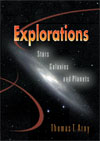Stellar Evolution 211 7.1 The Evolution of a Star 212 The Sun's Life Story 213 The Life Story of a High-Mass Star 214 The Importance of Gravity 215
7.2 Star Formation 216 Interstellar Gas Clouds 216 Protostars 217 Bipolar Flows from Young Stars 217 Stellar Mass Limits 219
7.3 Main-Sequence Stars 220 Why a Star's Mass Determines Its Core Temperature 220 Structure of High-Mass and Low-Mass Stars 220 Main-Sequence Lifetime of a Star 221
7.4 Giant Stars 222 Leaving the Main Sequence 222 Nuclear Fuels Heavier Than Hydrogen 222 Degeneracy in Low-Mass Stars 223
7.5 Yellow Giants and Pulsating Stars 224 Why Do Stars Pulsate? 224 The Period-Luminosity Law 226
7.6 Death of Stars Like the Sun 226 Ejection of a Low-Mass Star's Outer Layers 226 Re-Modeling: Planetary Nebulas 227 Planetary Nebulas 227
7.7 Old Age of Massive Stars 229 Formation of Heavy Elements: Nucleosynthesis 230 Core Collapse of Massive Stars 230 Supernova Explosions 231 Supernova Remnants 231
7.8 History of Stellar Evolution Theories 233 7.9 Testing Stellar Evolution Theory 234 | 


 2002 McGraw-Hill Higher Education
2002 McGraw-Hill Higher Education